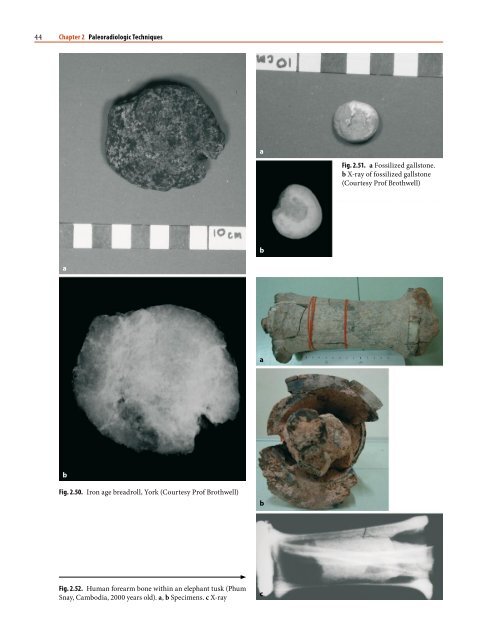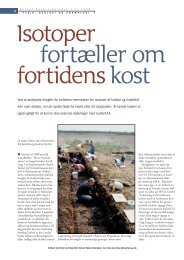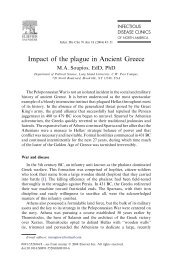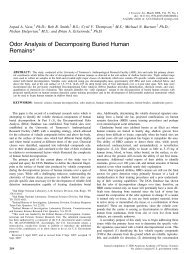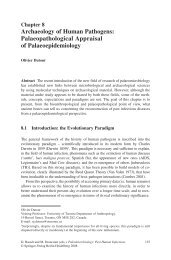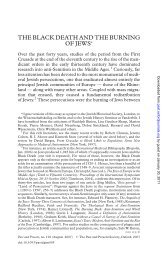1 Paleoradiology: History and New Developments - Academia.dk
1 Paleoradiology: History and New Developments - Academia.dk
1 Paleoradiology: History and New Developments - Academia.dk
You also want an ePaper? Increase the reach of your titles
YUMPU automatically turns print PDFs into web optimized ePapers that Google loves.
Chapter 2<br />
Paleoradiologic Techniques<br />
George Saab, Rethy K. Chhem, <strong>and</strong> Richard N. Bohay<br />
2.1<br />
X-ray Imaging For Bioarcheology<br />
X-ray imaging is used in three main types of human<br />
bioarcheological investigations. The first deals with<br />
the identification of anatomical structures that allow<br />
the determination of the stature, age at death,<br />
<strong>and</strong> gender. The second is to identify diseases in ancient<br />
skeletal remains <strong>and</strong> mummies. The last is the<br />
study of hominid fossils embedded in a burial matrix<br />
(Chhem <strong>and</strong> Ruhli 2004). In order to achieve these<br />
goals, bioarcheologists may need to undertake several<br />
steps. Bioarcheological materials can be submitted<br />
first to an x-ray investigation, <strong>and</strong> high-quality images<br />
can be obtained. The images are stored either on<br />
the traditional x-ray films or, more recently, on digital<br />
data supports. The ideal image analysis will be performed<br />
by radiologists with not only a qualification<br />
in musculoskeletal pathologies, but also equipped<br />
with an adequate <strong>and</strong> working knowledge of ancient<br />
bioarcheological materials. Alternatively, there can be<br />
collaboration between bioarcheologist <strong>and</strong> radiologist.<br />
These steps underline the need for adequate xray<br />
equipment <strong>and</strong> appropriate qualification in paleoradiology<br />
(Chhem 2006). X-ray studies have also been<br />
used to evaluate cultural material from archeological<br />
settings (Lang <strong>and</strong> Middleton 1997).<br />
This chapter provides a general description of<br />
conventional <strong>and</strong> advanced imaging techniques suitable<br />
for bioarcheological applications. These include<br />
analogue <strong>and</strong> digital radiography, imaging physics,<br />
digital archiving, recent developments in computed<br />
tomography (CT), novel imaging methods, <strong>and</strong> threedimensional<br />
specimen reconstruction techniques. A<br />
section on dental radiography has also been included.<br />
The imaging physics principles contained herein are<br />
not meant to be comprehensive, but rather to elucidate<br />
simple radiographic production factors that produce<br />
the best possible images. These factors exploit two<br />
important distinctions between bioarcheological <strong>and</strong><br />
medical imaging applications: (1) the specimens do<br />
not move <strong>and</strong> (2) the total x-ray dose is less of a concern<br />
than it would be with a living subject. Emphasis<br />
is given to those technical factors that can be cont-<br />
rolled without costly upgrades. Care has been taken<br />
to avoid the use of physics <strong>and</strong> mathematical jargon<br />
in order to make this chapter accessible to readers without<br />
a background in radiology <strong>and</strong> physics.<br />
X-ray equipment is available either in a hospital<br />
radiology department or in an anthropology department.<br />
In the former, one faces a few challenges,<br />
including the lack of specialized staff for taking radiographs<br />
of bioarcheological materials, but also the<br />
competition with clinical services. However, this<br />
is where one can have access to more advanced <strong>and</strong><br />
costly imaging procedures such as CT scanning. Hospital<br />
x-ray equipments have also been used successfully<br />
to image 1-million-year-old slate fossils from the<br />
Devonian era (Hohenstein 2004). These plates of slate<br />
measure around 35 mm in thickness <strong>and</strong> contain a<br />
large variety of fossilized specimens including sponges,<br />
jellyfish, coral, mollusks, worms, <strong>and</strong> arthropods.<br />
The role of x-ray was to identify the fossilized animals,<br />
<strong>and</strong> to guide their exposure <strong>and</strong> preparation for paleontological<br />
study. Conversely, some x-ray equipment<br />
already available in an anthropology department may<br />
have a few limitations. Some types of x-ray equipment<br />
designed to study small specimens may not allow the<br />
study of an entire mummy or a large bone such as the<br />
femur or pelvis. In either department, mastering key<br />
concepts in x-ray imaging will help bioarcheologists<br />
to obtain the highest-quality image from their specimens.<br />
Beyond hospital facilities, a research imaging<br />
center offers the most cutting-edge technology (micro-CT<br />
scan <strong>and</strong> others) for the radiological assessment<br />
of bioarcheological materials. From this short<br />
review, bioarcheologists are facing technical, scientific,<br />
medical, <strong>and</strong> financial issues. Access to x-ray<br />
facilities, especially advanced imaging tests, represents<br />
the first challenge. Finding the expert to read<br />
<strong>and</strong> interpret the findings is also a major challenge.<br />
Diagnostic errors are common in paleopathology not<br />
only when x-rays are read by a radiologist with no<br />
specialized qualification in musculoskeletal pathologies,<br />
but also when the reader has no knowledge of the<br />
taphonomic processes that have altered the physical<br />
characteristics of skeletal specimens relative to those<br />
of the live clinical model. This stresses the value of a<br />
2


